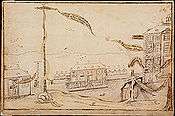Pierre Eugene du Simitiere


Pierre Eugene du Simitiere (born Pierre-Eugène Ducimetière, French: [pjɛʁ øʒɛn dysimtjɛʁ]; 18 September 1737,[1] Geneva – October 1784, Philadelphia, Pennsylvania) was a Swiss American member of the American Philosophical Society, naturalist, American patriot, and portrait painter.
Biography
Born in Geneva, du Simitiere's original name was Pierre-Eugène Ducimetière or Pierre-Eugène du Cimetière. After leaving Switzerland, he spent more than a decade in the West Indies before moving to New York and then Philadelphia. He spelled his name Pierre-Eugène du Simitière, Pierre Eugene du Simitiere or du Symitiere after settling in Philadelphia. Elected to the American Philosophical Society in 1768, he further became one of its curators (1777–81).
Du Simitiere served as the artistic consultant for the committees that designed the Great Seal of the United States, and in 1776 he submitted the first proposed design to include the Eye of Providence, which element was eventually adopted.[2] Moreover, he suggested the adoption of the U.S. motto E pluribus unum ("Out of Many, One"). He also designed the Seal of New Jersey,[3] of Delaware, and of Georgia. In 1779, du Simitiere painted the first known portrait of George Washington, later used for the 1791 one-cent coin. In 1781, he was conferred an honorary degree from Princeton University (which was still called College of New Jersey until 1896). Thomas Jefferson's daughter Martha took drawing lessons with du Simitiere.
Legacy
He created the first American museum of natural history[4] from his personal collections constituted during his travels and through his purchases. He opened it to the public in 1782, over forty years before the Charleston Museum, which is generally considered the first of all American museums.
His coin collection was the first record in Early American history to serve as collateral on a loan granted to him by William Dilwyn. This collection later on was sold at public auction by Matthew Clarkson and Ebenezer Hazard, on March 19, 1785 at Philadelphia. Included in the sale as Lot #19 was "A Mahogany cabinet containing ancient and modern Gold, Silver, and Copper Coins and Medals."[5] This sale precedes all sales in Atinelli's Numisgraphics [6] by 43 years and is considered to be the first known coin auction sale in America.[7] An advertisement for this sale reposes in the Archives of the Library Company of Philadelphia.
Du Simitiere has living descendants throughout Switzerland, France, and the US.
Notes
- ↑ Helmut Stalder, Swiss made – die Dollarnote, Beobachter 26/2010 (December 24, 2010).
- ↑ Submissions of the first Great Seal Committee, at GreatSeal.com
- ↑ "The Great Seal of the State of New Jersey". Retrieved 2012-07-29.
- ↑ Levey, Martin (1951), "The First American Museum of Natural History", Isis, 42: 10–12, doi:10.1086/349228, JSTOR 226659
- ↑ [Orosz, Dr. Joel J. (1988). The Eagle That Is Forgotten. Bowers & Merena Galleries. ISBN 0-943161-16-9.]
- ↑ [Atinelli, E.J. (1876). Numisgraphics. Self Published.]
- ↑ Orosz, Joel (8 August 2014). "John N. Lupia's numismatic bibliography illuminates the history of the coin hobby". Coin World. Retrieved 20 May 2015.
References
- Orosz, Joel J., The Eagle That is Forgotten (Wolfenboro, 1988)
- Van Horne, John C., Pierre Eugene DuSimitiere: His American Museum 200 Years after (Philadelphia, 1985)
- "Du Simitière, Pierre-Eugène". SIKART dictionary and database.